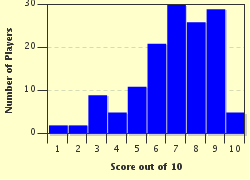Quiz Answer Key and Fun Facts
1. Where does a normal person's digestive process first start?
2. Digestion is the process by which nutrient molecules pass through the walls of your digestive system into your blood.
3. Which flap of tissue in the human body seals off the windpipe to prevent choking?
4. Which lubricating substance is produced in the esophagus to make food easier to swallow and move along?
5. Involuntary waves of muscle contraction in the esophagus are known by which name?
6. Processing of food into the liquid called chyme takes place in which of these?
7. What kind of acid does the stomach contain?
8. The small intestine is smaller than the larger intestine in size.
9. The liver aids in digestion.
10. Which of these is one of the functions of the large intestine?
Source: Author
foil7
This quiz was reviewed by FunTrivia editor
rossian before going online.
Any errors found in FunTrivia content are routinely corrected through our feedback system.


